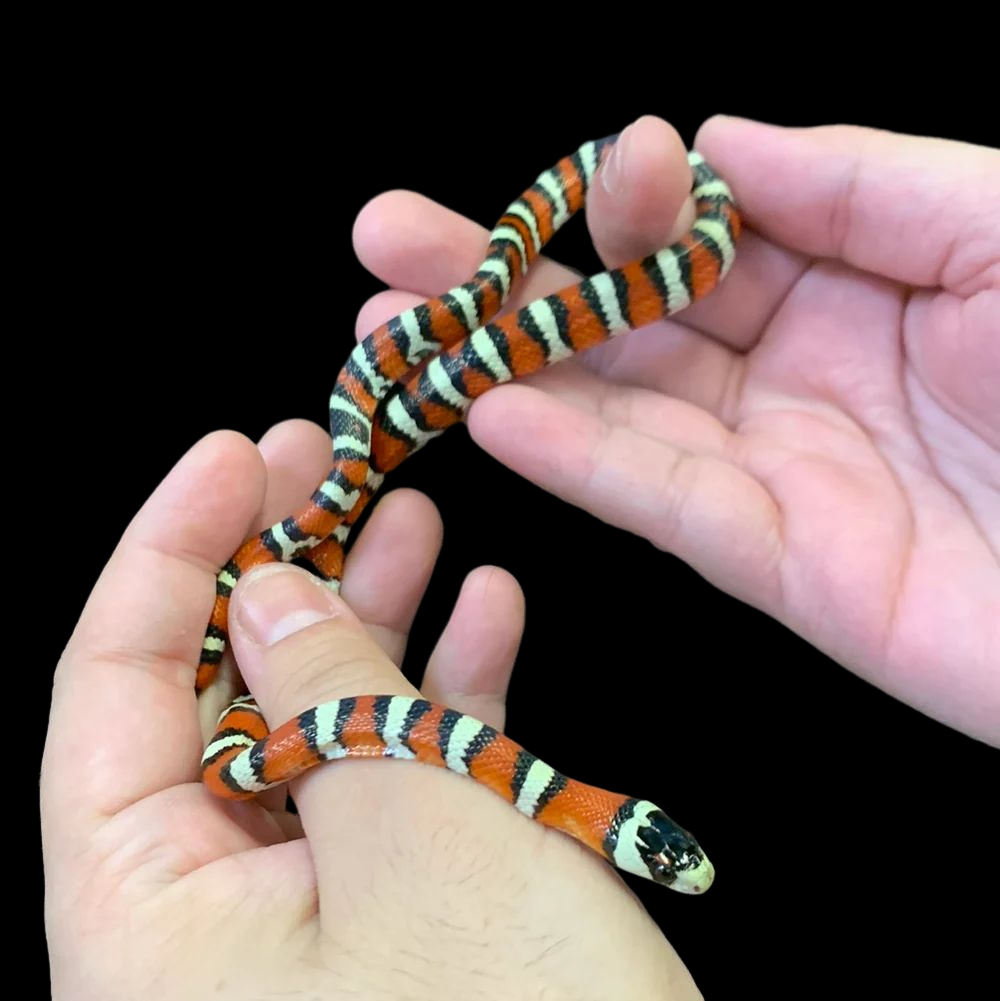Photo Disclaimer
Description
Arizona Mountain Kingsnake
Scientific Name: Lampropeltis pyromelana
Common Name: Arizona Mountain Kingsnake, Sonoran Mountain Kingsnake
Species Overview
Size: Adults typically reach 2.5–4 feet (0.8–1.2 m) in length, with a slender, smooth-scaled body and moderate girth.
Appearance: The Arizona Mountain Kingsnake is one of North America’s most strikingly coloured colubrids, displaying vivid bands of red, black, and white or cream. The pattern consists of alternating triads that often mimic the coral snake’s appearance—a case of Batesian mimicry that offers protection from predators. The intensity of the red and clarity of the white bands vary among localities, with some showing bright cherry-red coloration and others leaning toward orange or brick tones. The head is typically black with a contrasting white or yellow snout, and the eyes are dark and well-set. Juveniles hatch with vibrant colouration that remains bold into adulthood, making this species one of the most visually appealing kingsnakes in herpetoculture.
Distribution: Native to the southwestern United States and northern Mexico, found in Arizona, southwestern New Mexico, and portions of Sonora.
Habitat: Arizona Mountain Kingsnakes inhabit rocky slopes, pine and juniper forests, and arid mountain canyons throughout their range. In captivity, they thrive in naturalistic terrariums with soft substrate, climbing branches, and secure hiding areas.
Behaviour: This species is primarily diurnal and highly secretive, often sheltering beneath rocks or logs during the heat of the day. It is a capable climber and swift mover. Arizona Mountain Kingsnakes are generally calm and easy to handle, though they may initially musk when disturbed. With gentle care, they become curious and tolerant captives that rarely show defensive behaviour.
Captive Care
Enclosure: A 3-foot × 18-inch × 18-inch enclosure is suitable for adults, though larger enclosures promote more natural behaviour. Include rock ledges, cork bark, and branches for climbing. A loose, dry substrate such as aspen or a soil mix allows for burrowing.
Temperature & Humidity: Maintain a daytime gradient of 75–84°F (24–29°C) with a basking spot around 88°F (31°C). Nighttime temperatures can safely drop to 65–70°F (18–21°C). Keep humidity between 35–50%, with a slightly more humid hide provided for shedding.
Diet: Offer frozen-thawed pinkies or fuzzies every 5–7 days for juveniles and appropriately sized rodents every 10–14 days for adults. They are consistent feeders once acclimated, though some may benefit from scenting early in life.
Behaviour in Captivity: Arizona Mountain Kingsnakes are alert, inquisitive, and generally calm. They tolerate handling well and adapt readily to routine care. They are excellent display animals, showing both activity and striking coloration without aggressive tendencies.
Special Considerations: This species benefits from seasonal cooling or brumation to promote long-term health and successful breeding. Provide secure enclosure lids, as kingsnakes are adept escape artists.
Genetics Note
The Arizona Mountain Kingsnake exhibits a wide range of natural colour and pattern variation depending on locality, with some populations showing wider white bands, darker red hues, or reduced black edging. In captivity, selective breeding has emphasized these natural traits rather than producing new morphs, though rare Aberrant and Hypomelanistic (recessive) individuals have been documented. True genetic morphs remain uncommon; most variation seen in herpetoculture reflects the diverse wild phenotypes from regions such as the Huachuca, Santa Rita, and Chiricahua Mountains.
Species Summary
The Arizona Mountain Kingsnake (Lampropeltis pyromelana) is a vibrant, hardy, and gentle species beloved by collectors and naturalists alike. With its red, black, and white banding and calm demeanour, it exemplifies the beauty and adaptability of North American kingsnakes. Its natural variation, moderate size, and striking appearance make it an exceptional species for keepers seeking a visually iconic and manageable display animal.


